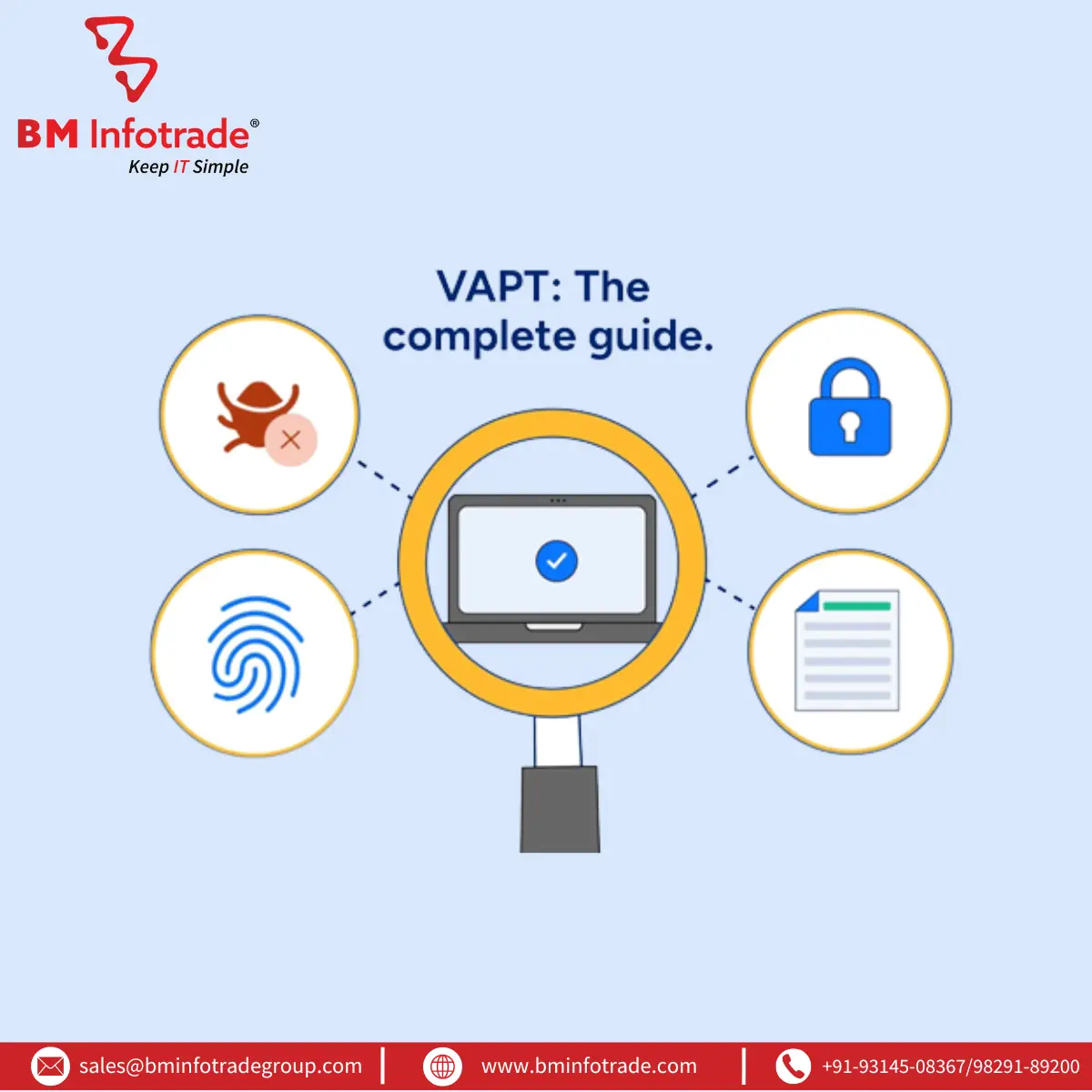What Happens in a Real VAPT? Full Process Explained With Sample Report
Uncover the full VAPT process with a clear, step-by-step guide. Explore how real Vulnerability Assessment & Penetration Testing is conducted and what a professional VAPT report includes.

What Happens in a Real VAPT? Full Process Explained With Sample Report
In the current cyber threat environment, no business can afford to leave its digital assets unprotected. This is where VAPT – Vulnerability Assessment and Penetration Testing – comes in. But what occurs during a VAPT exercise? What processes are involved? What is the outcome report? Let’s outline the entire workflow of a practical VAPT from preparation and execution to reporting.

What is VAPT?
VAPT is an acronym meaning Vulnerability Assessment and Penetration Testing. This is a hybrid security testing method that includes:
Vulnerability Assessment (VA): Scanning for and identifying existing security vulnerabilities.
Penetration Testing (PT): Simulating out exploiting the flaws as a real-life cyber attacker would.
Together, they combine to understand an organisation’s security posture not just by identifying what is weak, but also depicting how those weaknesses could potentially be exploited.
Why VAPT Is Critical Today
Given the rise in ransomware assaults, insider risks, and zero-day exploits, the use of firewalls in conjunction with antivirus software is therapeutically insufficient. VAPT emulates comprehensive cyberattacks to provide practical defence strategies.
The Real VAPT Process — Step-by-Step
Here’s what happens in a real VAPT cycle:
1. Scoping and Planning
This is where everything begins. The VAPT provider and the client define:
Assets to be tested (e.g., web applications, servers, networks, APIs).
Type of testing (black-box, white-box, or grey-box).
Rules of engagement (timings, test environment, contact person in case of emergency).
Exclusions and limitations (e.g., no DDoS, no phishing emails)
Deliverable: Signed NDA + formal Scope of Work (SOW)
2. Reconnaissance / Information Gathering
The testing team gathers as much public and private information about the target as possible.
Passive Recon: WHOIS data, DNS records, email IDs, and employee details from LinkedIn.
Active Recon: Port scanning, service enumeration, network sniffing, and OS fingerprinting.
Tools Used: Nmap, Shodan, TheHarvester, Maltego
3. Vulnerability Assessment
Now the scanners come into play.
Tools are used to scan for known vulnerabilities such as outdated libraries, weak cyphers, open ports, or default credentials.
This includes automated and manual analysis.
Common Tools: Nessus, OpenVAS, Burp Suite, Nikto, Nexpose
4. Exploitation (Penetration Testing)
This is the offensive stage.
The tester attempts to exploit the vulnerabilities identified in the previous step.
Examples:
Exploiting SQL Injection to dump the database.
Using a misconfigured S3 bucket to download sensitive files.
Bypassing authentication using session tokens.
Here, creativity and skill matter more than tools.
Manual testing is critical in this step—real attackers don’t rely only on tools.
5. Privilege Escalation and Lateral Movement
If initial access is achieved, testers will try to:
Escalate privileges (e.g., from a normal user to root/admin).
Move laterally to access deeper systems like the internal network or cloud admin panel.
This simulates how a real attacker would pivot once inside.
6. Post-Exploitation and Cleanup
Once data has been accessed or control gained, the tester:
Captures proof-of-concept evidence (e.g., screenshot of admin panel access) Logs everything.
Removes all test payloads, users, or scripts that could affect operations. Ethical testers leave no trace behind.
7. Report Creation
This is the most important part for business teams and developers.
The report includes:
Executive Summary (non-technical, for leadership).
Risk Ratings (Critical, High, Medium, Low).
Detailed Findings:
Description
Impact
Steps to Reproduce
Screenshots / PoC
Remediation Advice
Also Read:- Best VAPT Services in India: How to Choose the Right Vendor for Effective Vulnerability Assessment
Sample VAPT Report (Snippet)
Here’s a real-life style example from a web application test:
Critical Finding: SQL Injection on Login Page
URL: https://client-website.com/login
Payload Used: ' OR 1=1--
Impact: Full database dump including user credentials, PII, payment info
Proof of Concept: Tester was able to bypass login, extract the full user table
Remediation: Use parameterised queries. Sanitise user inputs. Apply WAF filtering
Medium Finding: Outdated Apache Version
Server: Apache 2.4.29 (Known RCE vulnerability CVE-2021-41773)
Impact: May allow remote code execution if exploited
Recommendation: Upgrade to the latest stable version (2.4.58)
Low Finding: Clickjacking Enabled
Issue: X-Frame-Options header missing
Impact: The Website can be embedded into malicious sites
Recommendation: Add header X-Frame-Options: DENY or SAMEORIGIN
What Happens After the VAPT?
Fixing and Retesting
Once the report is delivered:
The organisation fixes the issues (patching, hardening, rewriting code).
A remediation retest is performed to ensure issues are resolved.
Some companies go for continuous VAPT to test periodically.
How Often Should VAPT Be Done?
VAPT isn’t a one-time affair. It should be conducted:
Quarterly or bi-annually for dynamic environments
After major code changes or deployments
When compliance mandates demand it (e.g., PCI-DSS, ISO 27001).
Common Myths About VAPT
“Automated tools are enough.”
No. Tools can’t detect business logic flaws or chained vulnerabilities.
“It will crash my system.”
Not true if performed by certified professionals with scope limits.
“VAPT = Compliance.”
Compliance requires ongoing monitoring, not just a test report.
Certifications and Ethical Standards
Always ensure your VAPT provider uses:
Certified testers (CEH, OSCP, CISSP).
Legal authorisation and NDA.
Standard frameworks (OWASP, PTES, NIST).
Final Thoughts
A real-world VAPT is much more than running vulnerability scanners. It’s a detailed, offensive, and manual analysis of your systems, viewed through the eyes of a hacker but performed by professionals.
With increasing regulatory demands and cyberattacks, VAPT is not optional—it’s essential security hygiene for any organisation handling digital assets.
Whether you're a startup launching your first app or an enterprise securing sensitive data, knowing what happens inside a real VAPT helps you stay one step ahead of cybercriminals.
FAQ's
1. What is the difference between Vulnerability Assessment and Penetration Testing in VAPT?
Vulnerability Assessment identifies and lists security weaknesses using automated tools, while Penetration Testing actively exploits those vulnerabilities to assess their real-world impact and test the effectiveness of security controls.
2. How often should my business undergo VAPT assessments?
The frequency depends on industry regulations, changes in your IT environment, and evolving cyber threats, but most organizations conduct VAPT at least annually or after significant system changes.
3. What are the key phases of a VAPT process?
The main phases are: Planning & Scoping, Information Gathering, Vulnerability Assessment, Penetration Testing, Reporting & Remediation, and Retesting to verify fixes.
4. What should be included in a VAPT report?
A comprehensive VAPT report includes an executive summary, methodology, findings with severity ratings, risk assessment, remediation recommendations, technical details, and supporting evidence.
5. Why is a VAPT report important for compliance and security?
VAPT reports help organizations identify and prioritize security risks, meet compliance requirements (like PCI DSS, SOC 2, GDPR), improve their security posture, and prevent financial and reputational losses from cyberattacks.







Anshul Goyal
Group BDM at B M Infotrade | 11+ years Experience | Business Consultancy | Providing solutions in Cyber Security, Data Analytics, Cloud Computing, Digitization, Data and AI | IT Sales Leader